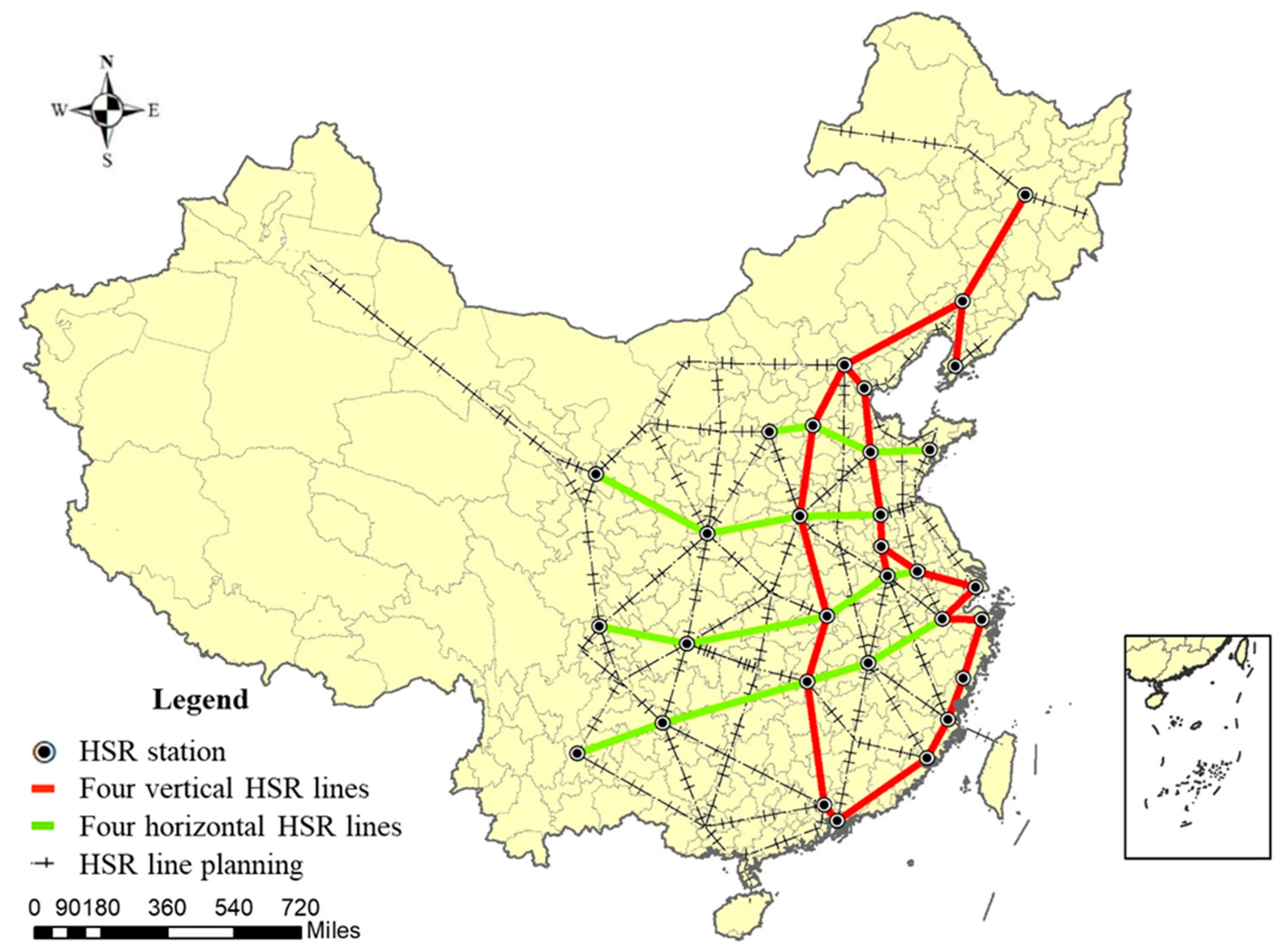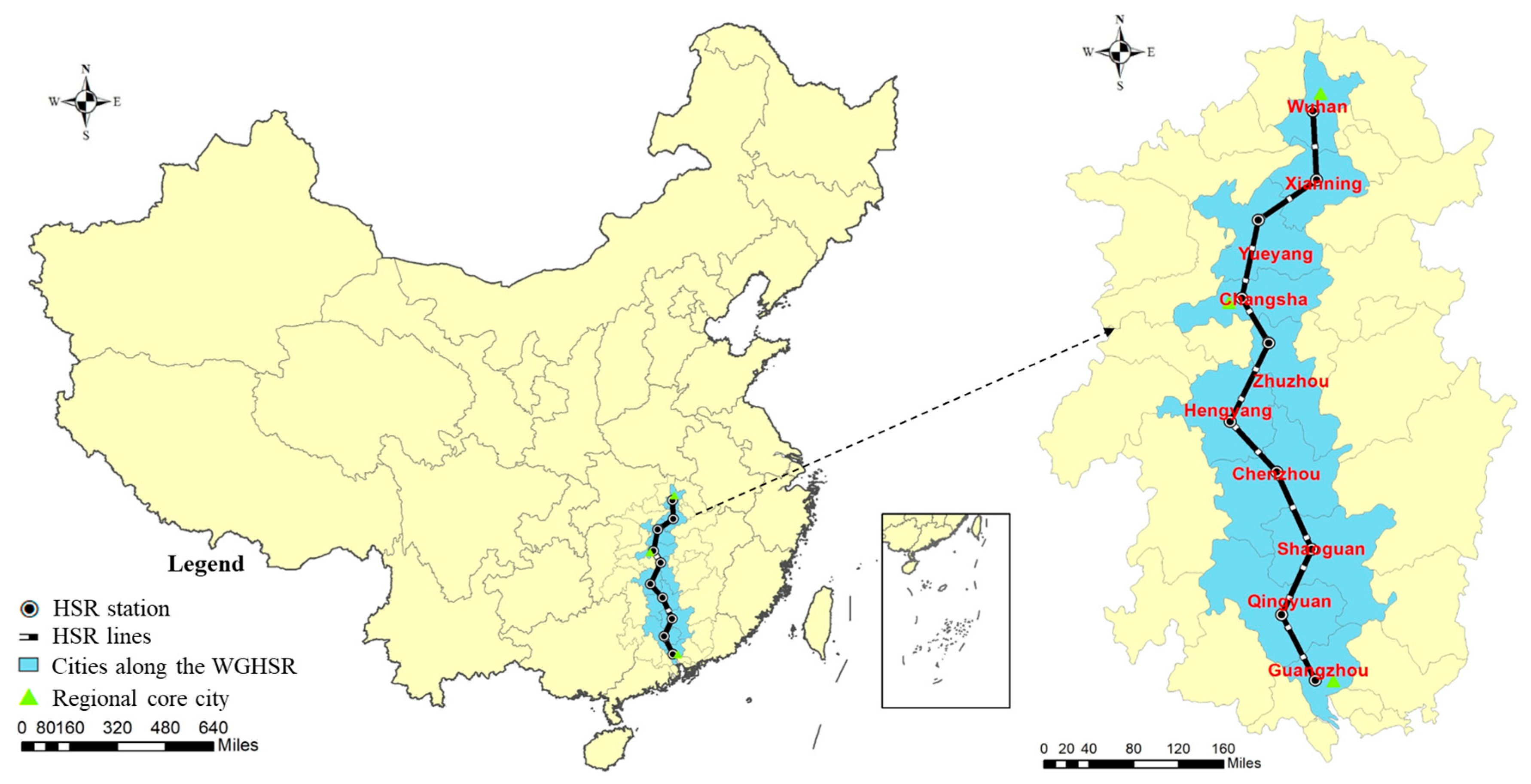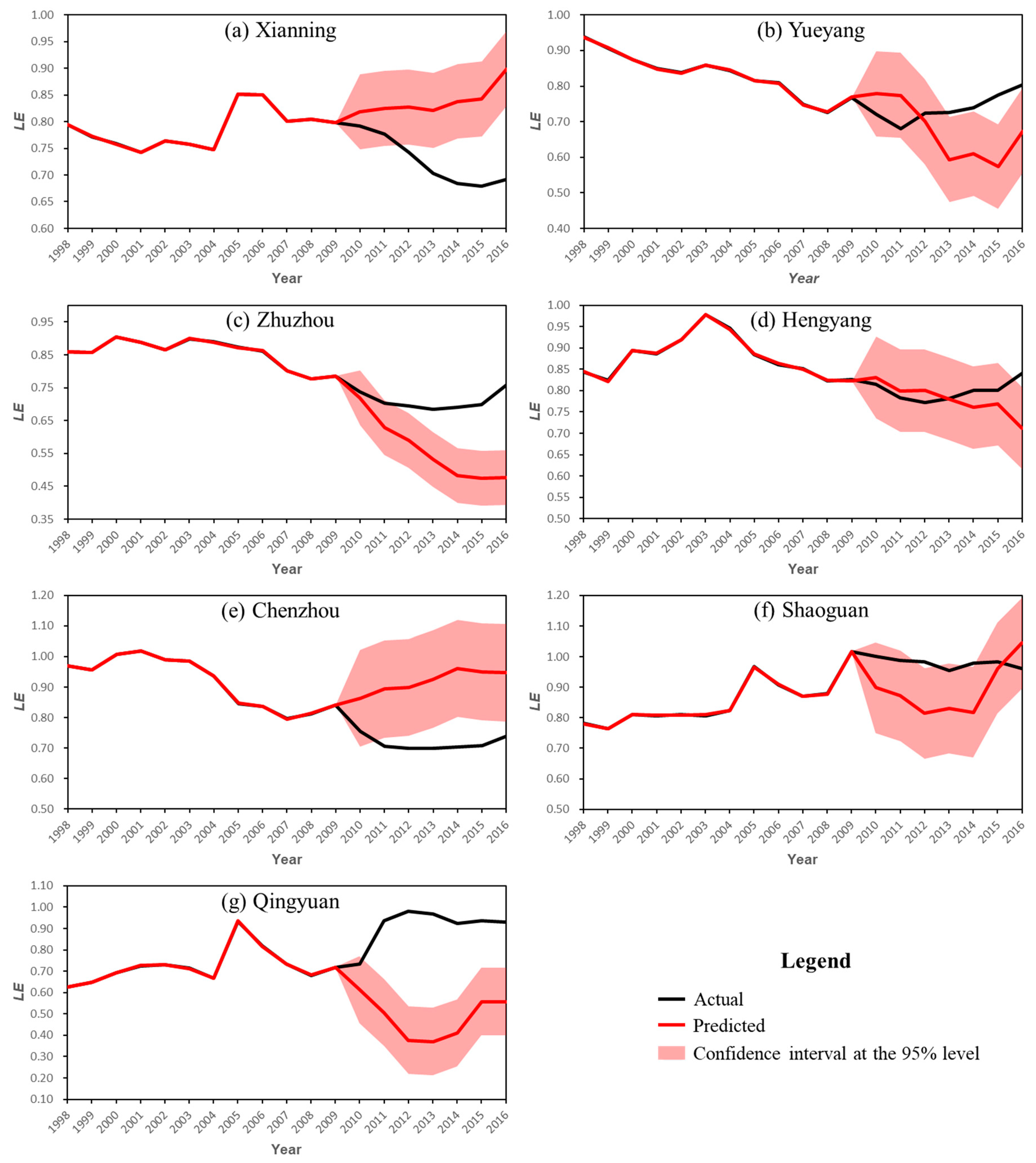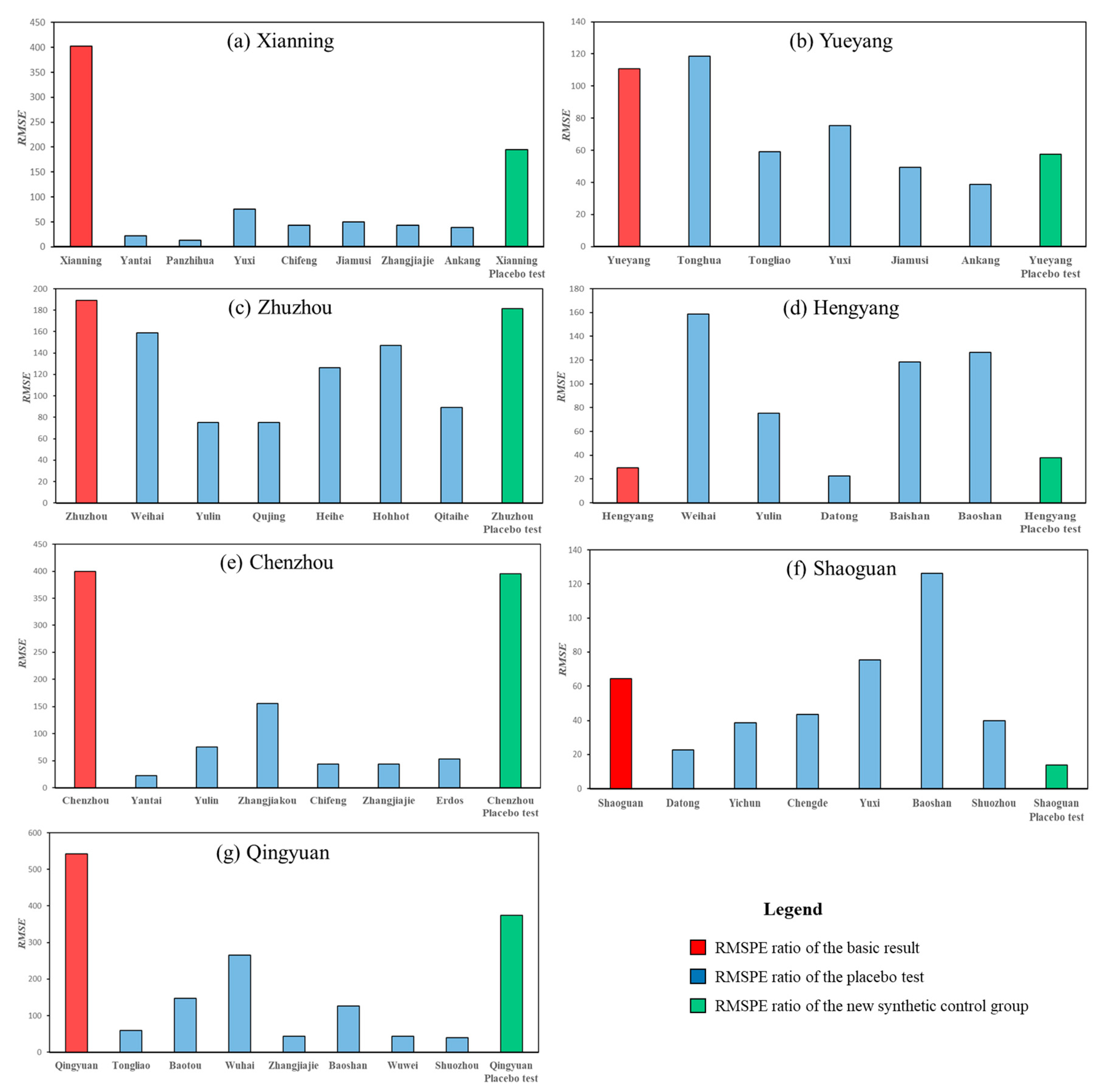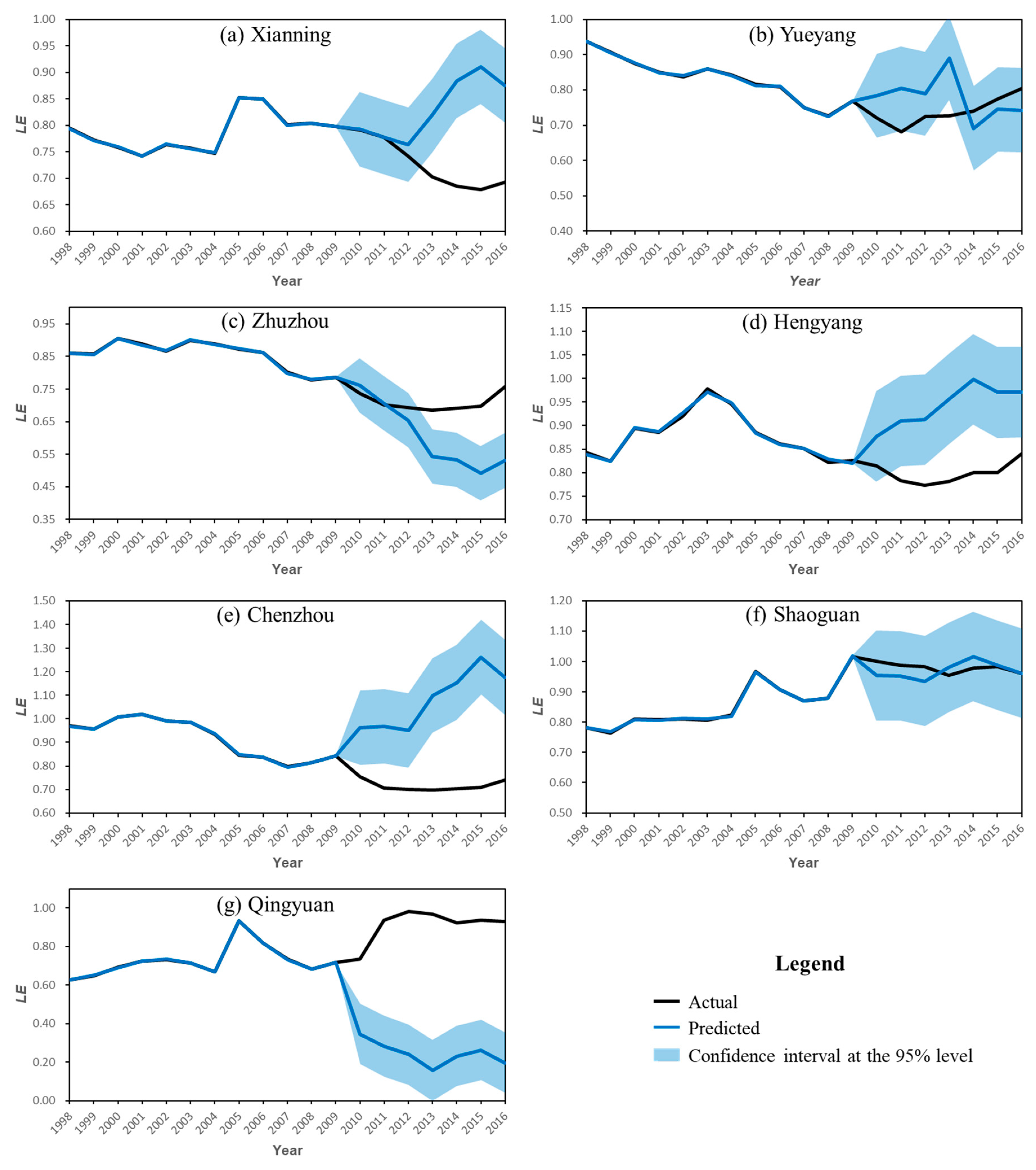1. Introduction
Newly lines designed for speeds above 250 km/h and upgraded existing lines for speeds of up to 200 km/h are considered as high-speed rail [
1]. Although China’s HSR construction started late, its development has been fast. After about two decades of construction, China has developed the HSR with the longest operating range, largest carrying capacity and largest geographical coverage in the world. According to information from the China Railway Corporation, ever since the first HSR line started operations in 2008, China had successfully constructed 25,000 km of HSR as of 2017, thus accounting for 66.3% of the world’s total HSR length. In addition, the HSR network framework of the Four Horizontal Lines and Four Vertical Lines layout was formed (
Figure 1). According to the 13th Five-Year Plan for Railway development, China’s HSR operating mileage will reach to 30,000 km, covering more than 80 percent of big cities. In addition, China will form the HSR network of Eight Horizontal Lines and Eight Vertical Lines.
Transport cost is an important factor affecting regional economic development, which can reduce trade costs and increase trade volume [
2,
3,
4]. Among all means of transportation, HSR is particularly important and exerts a crucial impact on the economy of regions along HSR lines [
5]. It is generally believed that HSR could improve accessibility, produce the time-space compression effect, facilitate the spatial (re)distribution of factor resources and exert impacts on regional economy. Accessibility refers to the convenience of using a certain transport system to reach a venue from a certain location [
6]. HSR affects interactions among cities, which affect the factor agglomeration costs. Eventually, it facilitates the spatial reallocation of diverse resources, including human resources, natural resources, technology, knowledge, and information [
7,
8,
9,
10]. The reallocation effect of resources caused by HSR is known as the HSR economic distribution effect in new economic geography [
11]. Such HSR economic distribution effects exist between the HSR cities and non-HSR cities, and they also exist within the cities along HSR lines. Besides that, the development of HSR also promotes the development of tourism because it is more comfortable and convenient than other modes of transportation. The research on the impact of HSR on the tourism draws much attentions and lead to fruitful achievements [
12,
13,
14,
15].
Since HSR serves primary passengers, it directly affects the service-sector the most. Differing from traditional manufacturing productions that are storable and easy for long distance transportation, the production and consumption of service products are identical in space and time [
16]. The shortcoming of service sector can be alleviated by the HSR to some extent. HSR helps the cities to connect with a wider range of markets and industry chains. China has a vast territory and exhibits a marked development gradient in which there are huge differences between the economic development in East China, Central China, and West China [
17,
18]. Hence, balancing the development between regions is an important task [
19,
20]. Given China’s growing labor costs and resource environment in recent years, proactively developing the service-sector is crucial to China’s industrial transformation and upgrading [
21]. On the one hand, developing the service-sector helps achieve industrial transformation. On the other hand, the service-sector agglomeration (SSA) plays three types of roles as a high-end industry: comprehensively supporting the entire industrial system, widely driving various industries, and promoting and upgrading the industrial structure [
22]. In general, HSR substantially improves regional accessibility and convenience, accelerates resource flows and optimizes the spatial distribution of the service sector. Therefore, it is expected that the Chinese large-scale construction of HSR aims at: (a) balancing the differences between regional development, and (b) ensuring China’s sustained economic growth. Against the above backdrop, we attempt to tackle the following questions: How did HSR affect the SSA in cities along the HSR lines? Has the SSA been promoted or suppressed? How can one estimate such an impact reliably?
In terms of research methods, comparative method and treatment effect model are usually employed to estimate the effect of HSR. The comparative analysis method horizontally compares the economy between opened and unopened HSR cities or it longitudinally compares the economy before and after the opening of HSR, which are commonly used to estimate HSR’s impacts. A drawback of the method is that it neglects the difference between economies of cities with HSR and without HSR. It is also unable to consider the changes in the economies of non-HSR cities before and after the opening of the HSR. In recent years, scholars have used quasi-natural experiments to construct conditions that are contrary to the facts and to estimate various changes that might have occurred in economic activities without HSR. Scholars regarded the opening of the HSR as a natural experiment and set cities as experimental research subjects. The HSR cities are assigned to the treatment group, and the non-HSR cities are assigned to the control group. The difference-in-difference (DID) method is currently the most commonly used treatment effect method. Many scholars used the DID method to more accurately estimate the impacts of HSR compared to the comparative analysis method. Remarkably, the DID method requires that the treatment group and control group should experience the same impacts from common factors. In addition, the only difference between the treatment group and the control group lies in whether they are affected by HSR.
A large volume of literature focuses on whether the HSR will promote economic development and there are three views on this question. First, some studies point out that HSR can accelerates the resources flowing and promotes economic development [
23,
24,
25,
26]; Second, some studies suggest that HSR has a disadvantage on the economic development to some extent, which largely due to its high-cost of building, operating, maintaining, and so on [
27,
28,
29,
30]; Third, it is also found that HSR exerts uneven impacts across the space, which means HSR’s impacts vary across different cities or different stages of the operation of HSR. According to the New Economic Geography (NEG) theory, the improvement of transportation infrastructure will reduce transportation costs, save trading time and enhance the flow of economic activities, which facilitates the formation of the “Core-Periphery” pattern [
11]. Thus, the HSR’s impact are different and multi-leveled in the various regions [
31,
32,
33,
34].
Table 1 summarized the different research findings on impacts of HSR in Asia.
In terms of the spatial structure, there may be spatial correlations between the economic indicators of different regions [
35]. It is believed that the spatial spillover effect and “siphon” effect are caused by such spatial correlations. Positive spatial correlations exist if the spillover effect exceeds the “siphon” effect. Otherwise, there are negative spatial correlations. Because HSR affects the interactions among cities, it is possible that HSR can change the magnitude of such spatial correlations. One possible situation is that HSR enhances the transfer of factors from the core to the periphery in a region through the spillover effect, facilitates the development of the periphery and accelerates economic growth of the whole region. Another possible situation is that HSR accelerates the transfer of factors from the periphery to the core and that the development of the periphery is inhibited under the “siphon” effect. Whether and how much HSR influences economic development requires other supplement conditions to be met. It is difficult to evaluate the economic effect. Similarly, evaluating the impacts of HSR on the economy is not easy. It is mainly because HSR’s impacts are influenced by various factors, including the line location, construction costs, and environmental costs. In addition, it is difficult to measure the indirect effect brought by HSR effectively [
36]. As a national strategic plan in China, the construction goal of HSR is to form regional fast traffic “corridors” to link the cities. Therefore, evaluating the impact of HSR is of great significance for balancing regional economy and promoting sustainable development.
In summary, although progresses have made in the research on HSR, there remain some questions to be addressed. On the one hand, little has been done regarding the spatial heterogeneity of HSR’s impacts, the transfers of regional industry and the changes in industrial spatial patterns. Because of this, existing studies rarely inspire the formulation of effective urban/regional economic policies. On the other hand, the DID method usually stacks all treatment units together. As a result, only the whole region’s effect can be estimated, and little has been done on the HSR impacts on every city. In light of the above, we employed a new counterfactual analytical method proposed by Hsiao et al. [
37] (namely the HCW model) to estimate the HSR’s impact on the SSA. The characteristic of the HCW model is to assume that the objects are influenced by some common factors, but the impact of these common factors on each object is heterogeneous. Moreover, in the application of the HCW model, it does not need to measure the common factors’ impact, but to use the change of the cross-sectional correlation of the objects to evaluate the policy’s effect. This feature makes the HCW method easy to use when compared to the DID method. Therefore, this method has been widely used and achieved much in the research on the policy evaluation [
38,
39,
40].
Based on the HCW model, we collected prefectural-level data between 1998 and 2016 to examine how the Wuhan–Guangzhou HSR (WGSHR) influences the service-sector agglomeration (SSA). To investigate the impacts of the WGSHR on SSA, we identified the control group for each city along the WGHSR. We found that the WGHSR significantly promoted the SSA along the line. However, the impacts of the WGHSR on SSA are heterogeneous. We not only enrich the quantitative research on the HSR economy but also provide extra references for planning the construction of China’s HSR and a basis for promoting the service-sector transfer and balancing regional development.
The remaining sections of this paper are arranged as follows. In
Section 2, the research objects and data of the paper are described. In
Section 3, we elaborate on the methodology and data. In
Section 4, the results of the empirical analysis and the robustness test are reported.
Section 5 consists of the conclusions and policy discussions.
5. Conclusions and Policy Implications
As HSR significantly reduces the restrictions of spatial distance on the flows of factor resources, it exerts a profound impact on the service-sector with fast flows of factor resources. Although scholars have been concerned that HSR can significantly affect the distribution of the service-sector, there are still some deficiencies in the existing studies. Because it is difficult to assess the impacts of HSR, there is no accurate conclusion at present. In this paper, prefectural-level data from 1998 to 2016 and a panel data program evaluation method are employed to evaluate the effect of the Wuhan–Guangzhou HSR (WGHSR) on the SSA along the route. Specifically, we predict the SSA index of the HSR cities along the route in the absence of the HSR using the SSA index in selected non-HSR cities. In order to achieve this, we identify the optimal control group for each city along the WGHSR and calculate the potential SSA index. By comparing the predicted index and the actual index, the evaluation of the WGHSR’s impact on the SSA can be obtained. Two robustness tests show that out conclusions are robust.
According to the research findings, the WGHSR has increased SSA significantly. However, we also find that the impacts of the WGHSR on SSA are heterogeneous. We believe that WGHSR has brought about both the spillover effect and the “siphon” effect. On the one hand, HSR increases the flow of factor resources from regional core cities to regional periphery cities and facilitates the development and agglomeration of service industries in some cities under the spillover effect. On the other hand, HSR accelerates the transfer of factor resources from marginal regions to core cities and facilitates the development and SSA under the “siphon” effect. It should be noted that every econometric method has its limitations. The HCW method is easy to use which dues to it is efficient on constructing the optimal synthetic control group of every HSR city along the WGHSR. The prediction process of the SSA index is based on just one single variable which may not be effective to reflect the complex relationship between different cities. Therefore, the conclusions of this research still need follow-up study and further confirmation by relevant studies.
In the context of energetic efforts of HSR construction, whether a city gives play to its advantages is the key to ensuring its development. Based on our findings, we propose the following policy advice.
First, enhance the planning of constructing HSR networks and further perfect current HSR networks. As an important means of transportation between cities, HSR is characterized by fast speed and convenience, which brings huge revolutions to urban development. In addition, HSR has typical network economic effects and the impact of one HSR line in a region on the industrial layout is limited. Only when forming an HSR network will the effects on regional economic development be more significant. To achieve this objective, the HSR network should be planned scientifically. It is thus necessary to enhance the planning of constructing HSR networks from the perspective of enhancing inter-city economic connections and accelerating regional economic integration. It is the precondition of achieving a reasonable layout and facilitating economic development in all cities.
Second, relying on HSR implements differentiated regional development strategies. The impact of HSR on the regional economy is spatially heterogeneous. It is necessary for all regions to enhance their connections with other regions, give full play to advantageous industries and facilitate development based on HSR. In addition, small cities should be good at seizing opportunities and accurately positioning and developing their advantageous characteristic industries to achieve differentiated competition. Moreover, big cities should enhance the efforts of undertaking international high-end industries and actively transfer out low-end industries to make room for industry upgrades. Furthermore, big cities should vigorously support the development of the service-sector and form complementary advantages between regions.
Third, the government should oversee possible market failures in HSR development and facilitate regional economic development on the principle of ensuring both efficiency and fairness.
